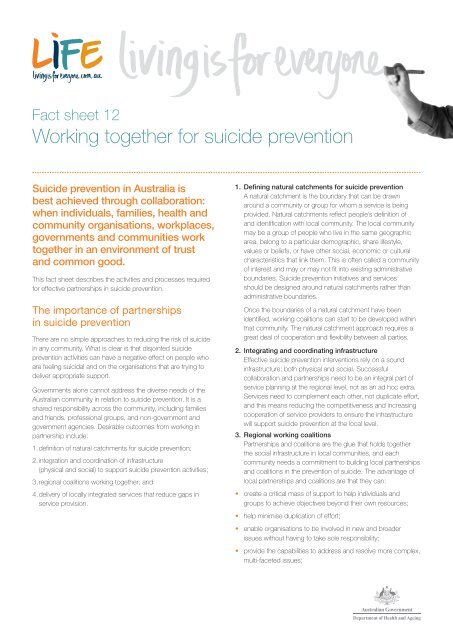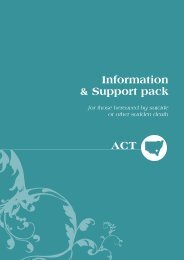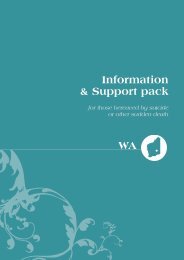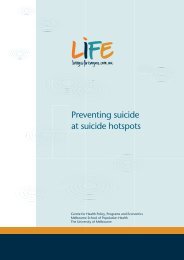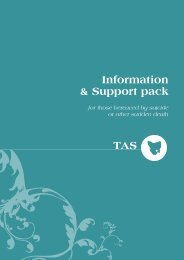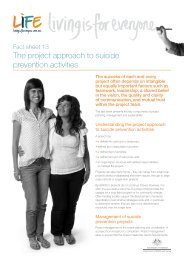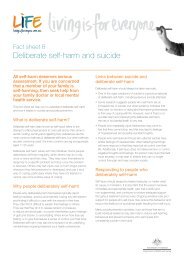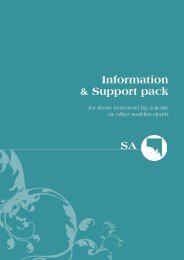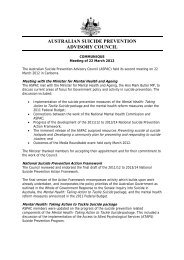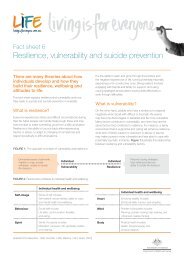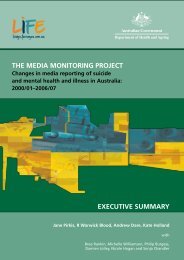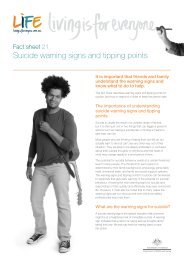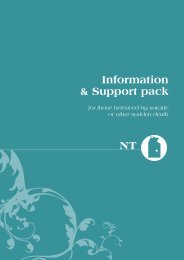Fact sheet 12: Working together for suicide prevention (406.23KB)
Fact sheet 12: Working together for suicide prevention (406.23KB)
Fact sheet 12: Working together for suicide prevention (406.23KB)
You also want an ePaper? Increase the reach of your titles
YUMPU automatically turns print PDFs into web optimized ePapers that Google loves.
<strong>Fact</strong> <strong>sheet</strong> <strong>12</strong><strong>Working</strong> <strong>together</strong> <strong>for</strong> <strong>suicide</strong> <strong>prevention</strong>Suicide <strong>prevention</strong> in Australia isbest achieved through collaboration:when individuals, families, health andcommunity organisations, workplaces,governments and communities work<strong>together</strong> in an environment of trustand common good.This fact <strong>sheet</strong> describes the activities and processes required<strong>for</strong> effective partnerships in <strong>suicide</strong> <strong>prevention</strong>.The importance of partnershipsin <strong>suicide</strong> <strong>prevention</strong>There are no simple approaches to reducing the risk of <strong>suicide</strong>in any community. What is clear is that disjointed <strong>suicide</strong><strong>prevention</strong> activities can have a negative effect on people whoare feeling suicidal and on the organisations that are trying todeliver appropriate support.Governments alone cannot address the diverse needs of theAustralian community in relation to <strong>suicide</strong> <strong>prevention</strong>. It is ashared responsibility across the community, including familiesand friends, professional groups, and non-government andgovernment agencies. Desirable outcomes from working inpartnership include:1. definition of natural catchments <strong>for</strong> <strong>suicide</strong> <strong>prevention</strong>;2. integration and coordination of infrastructure(physical and social) to support <strong>suicide</strong> <strong>prevention</strong> activities;3. regional coalitions working <strong>together</strong>; and4. delivery of locally integrated services that reduce gaps inservice provision.1. Defining natural catchments <strong>for</strong> <strong>suicide</strong> <strong>prevention</strong>A natural catchment is the boundary that can be drawnaround a community or group <strong>for</strong> whom a service is beingprovided. Natural catchments reflect people’s definition ofand identification with local community. The local communitymay be a group of people who live in the same geographicarea, belong to a particular demographic, share lifestyle,values or beliefs, or have other social, economic or culturalcharacteristics that link them. This is often called a communityof interest and may or may not fit into existing administrativeboundaries. Suicide <strong>prevention</strong> initiatives and servicesshould be designed around natural catchments rather thanadministrative boundaries.Once the boundaries of a natural catchment have beenidentified, working coalitions can start to be developed withinthat community. The natural catchment approach requires agreat deal of cooperation and flexibility between all parties.2. Integrating and coordinating infrastructureEffective <strong>suicide</strong> <strong>prevention</strong> interventions rely on a soundinfrastructure; both physical and social. Successfulcollaboration and partnerships need to be an integral part ofservice planning at the regional level, not as an ad hoc extra.Services need to complement each other, not duplicate ef<strong>for</strong>t,and this means reducing the competitiveness and increasingcooperation of service providers to ensure the infrastructurewill support <strong>suicide</strong> <strong>prevention</strong> at the local level.3. Regional working coalitionsPartnerships and coalitions are the glue that holds <strong>together</strong>the social infrastructure in local communities, and eachcommunity needs a commitment to building local partnershipsand coalitions in the <strong>prevention</strong> of <strong>suicide</strong>. The advantage oflocal partnerships and coalitions are that they can:• create a critical mass of support to help individuals andgroups to achieve objectives beyond their own resources;• help minimise duplication of ef<strong>for</strong>t;• enable organisations to be involved in new and broaderissues without having to take sole responsibility;• provide the capabilities to address and resolve more complex,multi-faceted issues;
• demonstrate and develop further public/community support<strong>for</strong> an issue;• empower individuals and groups through collective action;• build sustainability;• mobilise human capacities or talents, resources andapproaches;• provide an opportunity to recruit people from a diverse rangeof backgrounds including government and non-governmentagencies, education institutions, social and religious groupsand the business community;• are able to identify, attract and exploit new resources; and• create a seamless and linked service delivery.4. Delivering integrated local services to reduce gaps inservice provisionClear and effective pathways to care <strong>for</strong> people feelingsuicidal are a prerequisite to creating sustainable <strong>suicide</strong><strong>prevention</strong>. This requires community ownership andresponsibility <strong>for</strong> action, a focus on client-centred servicedelivery; strong partnerships, and coordination betweenservices including an ability to work cooperatively to analyseand deal effectively with complex problems. For integratedpathways to be achieved, the following is required:• Services need to be available. Better coordination of existingservices can often go far to address service shortage issues.This can be achieved through new approaches such astelehealth, internet-based services and through work<strong>for</strong>cerestructuring.• In<strong>for</strong>mation about services needs to be readily availableacross the community. Names and structures of servicescan change rapidly, so the in<strong>for</strong>mation system needs toaccommodate this.• Staff training is needed to provide skills in the detection andreferral of people at risk. The Mental Health First Aid level isa good start <strong>for</strong> staff outside health care. More advancedtraining can be tailored to specific groups of workers.• Referral needs to be easy and efficient, and people need tobe referred to the right agency or service so there is minimalrisk that they will fall through the cracks. This means buildingstrong working links between agencies, including by personalcontact and local networking.• The referral process needs to be related to the degree of risk.People at high risk should be personally accompanied to thenext service. At lower levels there should still be a systemin place to check that the person attended the referral, andfollow up if this did not take place. It is critical that the chainnot be broken, as levels of risk can change rapidly.• The referring practitioner needs feedback on the progressof their client and the appropriateness of the referral. If this isdone then everyone learns, the person gets a better service,and the system works better next time.Examples of integrated care pathways include:• Ensuring that a person exiting an in-patient psychiatricfacility is discharged to stable accommodation, is given animmediate appointment with a clinician accompanied by areferral letter, and has continuity of medication. Family, friendsor carers need to be in<strong>for</strong>med about discharge ahead oftime and given an opportunity to discuss their role, relapse<strong>prevention</strong> and the person’s ongoing care.• Ensuring that a person who has presented at a hospitalemergency department as having attempted or thinking of<strong>suicide</strong>, and has not been admitted to hospital, is referredimmediately to an appropriate service no matter what timeof the day or week.• Referral from a general practitioner - GPs are well placed todetect signs of risk (85 per cent of people in Australia visit aGP at least once a year). GPs can carry out a standard riskassessment, and refer a patient <strong>for</strong> a psychiatric assessmentor psychological treatment. The Medicare Benefits Schedule(MBS) makes these treatments more accessible.More in<strong>for</strong>mation• Building Partnerships, LIFE: A framework <strong>for</strong> the <strong>prevention</strong>of <strong>suicide</strong> and self-harm in Australia (2000). CommonwealthDepartment of Health and Aged Care: Canberra.• Living Is For Everyone (LIFE) – A Framework <strong>for</strong> Preventionof Suicide in Australia (2007). Commonwealth Departmentof Health and Ageing: Canberra.• Living Is For Everyone (LIFE) – Research and Evidence inSuicide Prevention (2007). Commonwealth Departmentof Health and Ageing: Canberra.The Australian Government Department of Health and Ageing has financially supported the productionof this document. While every ef<strong>for</strong>t has been made to ensure that the in<strong>for</strong>mation contained is accurateand up-to-date at the time of publication, the department does not accept responsibility <strong>for</strong> any errors,omissions or inaccuracies. © Commonwealth of Australia 2007. This work is copyright. Apart from anyuse as permitted under the Copyright Act 1968, no part may be reproduced by any process without priorwritten permission from the Commonwealth. Requests and inquiries concerning reproduction and rightsshould be addressed to the Commonwealth Copyright Administration, Attorney-General’s Department,Robert Garran Offices, National Circuit, Barton ACT 2600 or posted at http://www.ag.gov.au/cca


